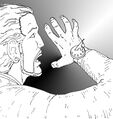Template:Selected anniversaries/August 31: Difference between revisions
No edit summary |
No edit summary |
||
| Line 29: | Line 29: | ||
||Heinrich Franz Friedrich Tietze (b. August 31, 1880) was an Austrian mathematician, famous for the Tietze extension theorem on functions from topological spaces to the real numbers. He also developed the Tietze transformations for group presentations, and was the first to pose the group isomorphism problem. | ||Heinrich Franz Friedrich Tietze (b. August 31, 1880) was an Austrian mathematician, famous for the Tietze extension theorem on functions from topological spaces to the real numbers. He also developed the Tietze transformations for group presentations, and was the first to pose the group isomorphism problem. | ||
||Friedrich Adolf Paneth | ||1887: Friedrich Adolf Paneth born ... chemist. | ||
||1895 | ||1895: Engelbert Zaschka born ... engineer and designer, invented the Human-powered aircraft. | ||
||1895 | ||1895: German Count Ferdinand von Zeppelin patents his navigable balloon. | ||
File:Thomas Edison.jpg|link=Thomas Edison (nonfiction)|1897: [[Thomas Edison (nonfiction)|Thomas Edison]] patents the Kinetoscope, the first movie projector. | File:Thomas Edison.jpg|link=Thomas Edison (nonfiction)|1897: [[Thomas Edison (nonfiction)|Thomas Edison]] patents the Kinetoscope, the first movie projector. | ||
|| | File:Georg Cantor 1894.png|link=Georg Cantor (nonfiction)|1899: [[Georg Cantor (nonfiction)|Georg Cantor]] writes to [[Richard Dedekind (nonfiction)|Dedekind]], remarking that his "diagonal process" could be used to show that the power set of a set has more elements than the set itself. | ||
|| | ||1905: Robert Bacher born ... physicist and academic. | ||
|| | ||1913: Bernard Lovell born ... physicist and astronomer. | ||
||1920 | ||1920: Louis Arthur Ducos du Hauron dies ... pioneer of color photography. He worked on developing practical processes for color photography on the three-color principle, using both additive and subtractive methods; and introduced the anaglyph stereoscopic print, the "red and blue glasses" type of 3-D print. Pic. | ||
||1920: The first radio news program is broadcast by 8MK in Detroit. | |||
||Wilhelm Maximilian Wundt (b. 31 August 1920) was a German physician, physiologist, philosopher, and professor, known today as one of the founding figures of modern psychology. Wundt, who noted psychology as a science apart from philosophy and biology, was the first person ever to call himself a psychologist. He is widely regarded as the "father of experimental psychology." Pic. | ||Wilhelm Maximilian Wundt (b. 31 August 1920) was a German physician, physiologist, philosopher, and professor, known today as one of the founding figures of modern psychology. Wundt, who noted psychology as a science apart from philosophy and biology, was the first person ever to call himself a psychologist. He is widely regarded as the "father of experimental psychology." Pic. | ||
Revision as of 08:15, 26 August 2018
1635: Mathematician, theologian, and crime-fighter Marin Mersenne uses new theory of acoustics to detect and prevent crimes against mathematical constants.
1649: Architect Inigo Jones uses Vitruvian rules of proportion and symmetry to design buildings which are resistant to crimes against mathematical constants.
1897: Thomas Edison patents the Kinetoscope, the first movie projector.
1899: Georg Cantor writes to Dedekind, remarking that his "diagonal process" could be used to show that the power set of a set has more elements than the set itself.
1945: Mathematician and academic Stefan Banach dies. He was one of the founders of modern functional analysis.
2017: Signed first edition of The Eel Discovers Time Travel sells for two and a half million dollars."





